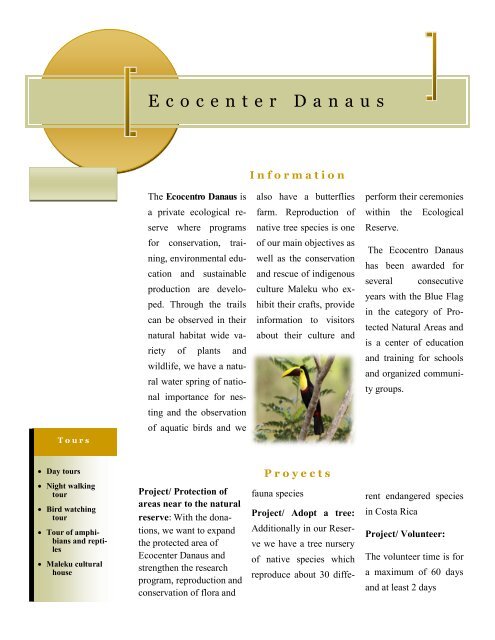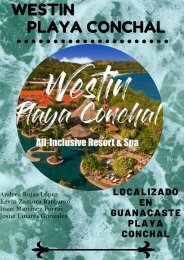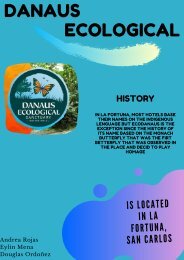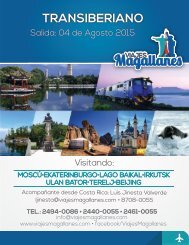danaus
You also want an ePaper? Increase the reach of your titles
YUMPU automatically turns print PDFs into web optimized ePapers that Google loves.
E c o c e n t e r D a n a u s<br />
I n f o r m a t i o n<br />
The Ecocentro Danaus is<br />
also have a butterflies<br />
perform their ceremonies<br />
a private ecological re-<br />
farm. Reproduction of<br />
within the Ecological<br />
serve where programs<br />
native tree species is one<br />
Reserve.<br />
for conservation, training,<br />
environmental education<br />
and sustainable<br />
production are developed.<br />
Through the trails<br />
can be observed in their<br />
natural habitat wide variety<br />
of plants and<br />
wildlife, we have a natural<br />
water spring of national<br />
importance for nes-<br />
of our main objectives as<br />
well as the conservation<br />
and rescue of indigenous<br />
culture Maleku who exhibit<br />
their crafts, provide<br />
information to visitors<br />
about their culture and<br />
The Ecocentro Danaus<br />
has been awarded for<br />
several consecutive<br />
years with the Blue Flag<br />
in the category of Protected<br />
Natural Areas and<br />
is a center of education<br />
and training for schools<br />
and organized community<br />
groups.<br />
ting and the observation<br />
of aquatic birds and we<br />
T o u r s<br />
Day tours<br />
Night walking<br />
tour<br />
Bird watching<br />
tour<br />
Tour of amphibians<br />
and reptiles<br />
Maleku cultural<br />
house<br />
Project/ Protection of<br />
areas near to the natural<br />
reserve: With the donations,<br />
we want to expand<br />
the protected area of<br />
Ecocenter Danaus and<br />
strengthen the research<br />
program, reproduction and<br />
conservation of flora and<br />
P r o y e c t s<br />
fauna species<br />
Project/ Adopt a tree:<br />
Additionally in our Reserve<br />
we have a tree nursery<br />
of native species which<br />
reproduce about 30 different<br />
endangered species<br />
in Costa Rica<br />
Project/ Volunteer:<br />
The volunteer time is for<br />
a maximum of 60 days<br />
and at least 2 days
D a n a u s E c o c e n t e r B i r d s<br />
Página 2<br />
T o u c a n c o l l a r e d<br />
Name cientific: Pteroglossus<br />
torquatus.<br />
Measure: 41cm<br />
Distingueshed from the fiery<br />
-billed Aracari by mostly<br />
chalky-white uuper mandible<br />
anda black belly band.<br />
Common in caribbean lowlandns,<br />
and decreasingly<br />
common up intro foothills;<br />
uncommon in northern pacific.<br />
Where usually found in gallery<br />
forest; 1000 m .<br />
Small groups travel<br />
through mature wet forest ,<br />
forest edge and adjancent<br />
gardens.<br />
Most often Heard vocalization<br />
is high-pitched , twonote<br />
“hiccup”.<br />
S c a l y - B r e a s t e d H u m m i n b i r d<br />
Name Cientific: Phaeochroa<br />
cuvierii.<br />
Measure: 13 cm<br />
A drab Hummer, but note<br />
White tips to the outer tail<br />
feathers; also note pink basal<br />
half of lower mandible. The<br />
breast does not appear conspicuosly<br />
scaly.<br />
Female Green-crowned brilland<br />
has short White malar<br />
stripe; female blue-chested<br />
hummingbird, charming<br />
hummingbird and White –<br />
necked jacobin show some<br />
bluue on chest.<br />
Common in dry and hummid<br />
pacific lowlands, southern<br />
pacific itermontane<br />
valleys, and in Caño Negro<br />
región; uncommon in wet<br />
lowlands of southern pacific<br />
and in Puerto Viejo de<br />
Sarapique area .<br />
Found at lower and middle<br />
levels along forest edge, in<br />
second growth and gardens,<br />
as in mangroves.<br />
Male sings rather well for a<br />
hummingbird; often sings<br />
from fairly high perch in<br />
second growth and gardens,<br />
A m e r i c a n P y g m y K i n g f i s h e r<br />
Name Cientific: Chloroceryle<br />
aenea<br />
Measure: 13cm.<br />
Favors swamp forests and<br />
shaded streams, occasionaly<br />
found in more expose<br />
situations.<br />
This is misniscule kingfisher<br />
is distinguished from the<br />
larger Green–and-rufous<br />
kingfisher by White belly<br />
and vent.<br />
Uncommon in lowlands to<br />
600m.
Página 3<br />
C l a y - C o l o r e d T h r u s h<br />
Name Cientific: Turdus<br />
grayi.<br />
Measure: 23cm.<br />
CR`s nondecript national<br />
bird, know locally as el<br />
yigüirro, can be distinguished<br />
from the mountain and<br />
pale-vented thrushes by its<br />
yellow-green bill.<br />
that hops on the ground in<br />
typical thrust fashion, routinely<br />
flicks its tail upon<br />
landing.<br />
From march through june,<br />
tirelessly whistles melodic<br />
phrases that are responsable<br />
for its status as the national<br />
bird of Costa Rica.<br />
Widespread and common,<br />
to 2,400m, though uncommon<br />
in northen pacific.<br />
A true gardenvariety bird<br />
B o a t - B i l l e d H e r o n<br />
Name Cientific: Cochlearius<br />
cochlearuis.<br />
Measure: 51cm.<br />
day in vegetation that<br />
overhangs ponds and<br />
streams.<br />
The strange-looking broad<br />
bill is the definitive field<br />
mark.<br />
Somewhat like adult blackcrowned<br />
night-heron, but is<br />
darker below.<br />
Fairly common and widespread<br />
in lowlands to 600m.<br />
Colonies nest and roost by<br />
B l u e - G r a y T a n a g e r<br />
Name Cientific: Thraupis<br />
episcopus.<br />
Measure: 15cm.<br />
Its simple song is Little<br />
more tan even-piched<br />
squeaks.<br />
In good light, there should<br />
be no confusion; in por<br />
light, can look quite gray<br />
and could be mistaken for<br />
palm tanager.<br />
One of the most common in<br />
northen pacific.
C o n t a c t<br />
Tephone: 24797019<br />
Cellphone: 89281478<br />
Email:<br />
<strong>danaus</strong>.reservas@hotmail.com<br />
Web: <strong>danaus</strong>@racsa.co.cr<br />
The ecological reserve<br />
welcomes visitors<br />
at any time of year,<br />
Monday to Sunday<br />
from 7:30 am to 5<br />
pm, the duration of<br />
the tour is from 1<br />
hour 30 minutes and<br />
are conducted by naturalists<br />
local guides<br />
with great experience,<br />
who speak English<br />
and have a extensive<br />
knowledge in natural<br />
and cultural history<br />
of the most outstanding<br />
species.








